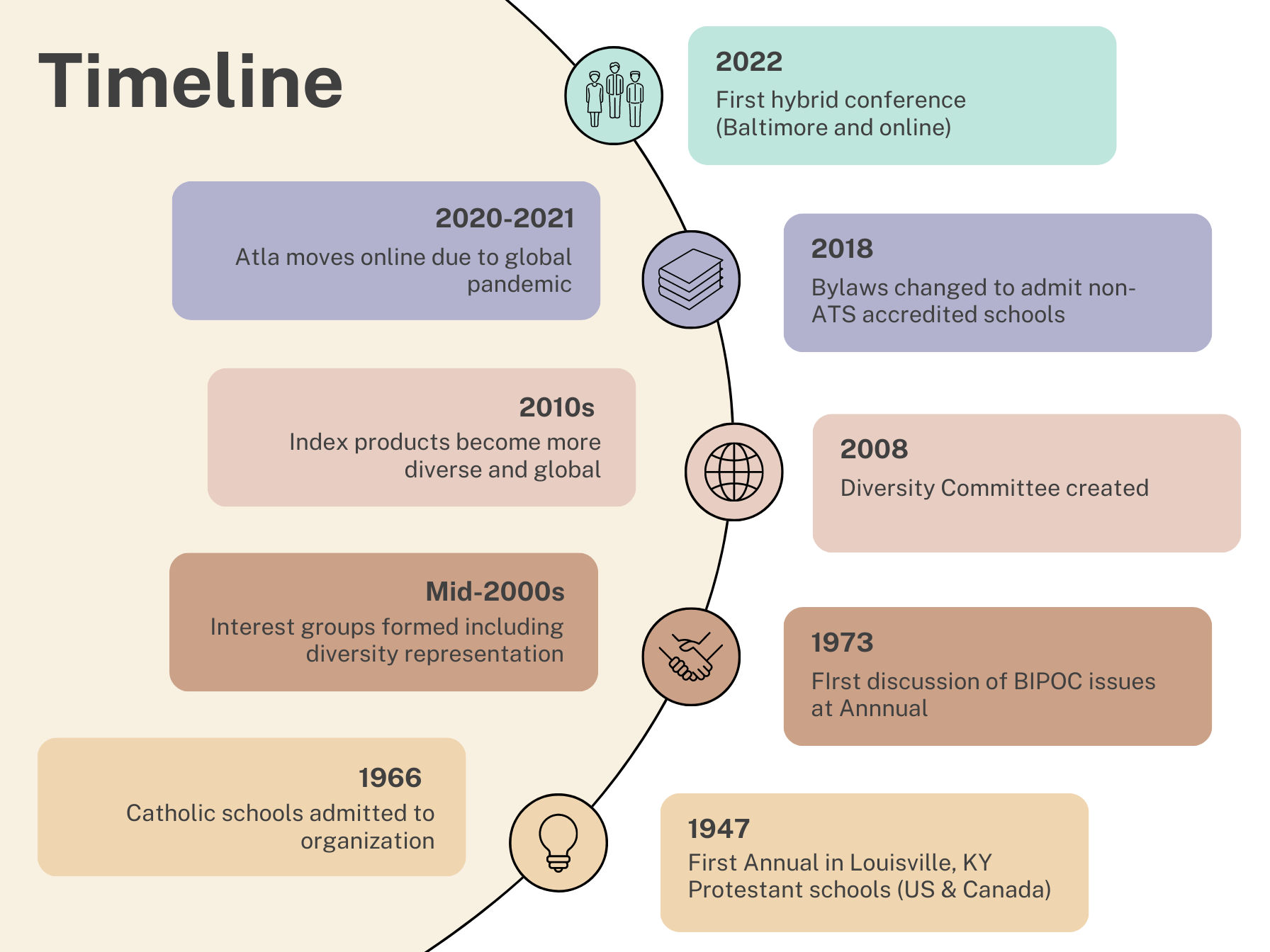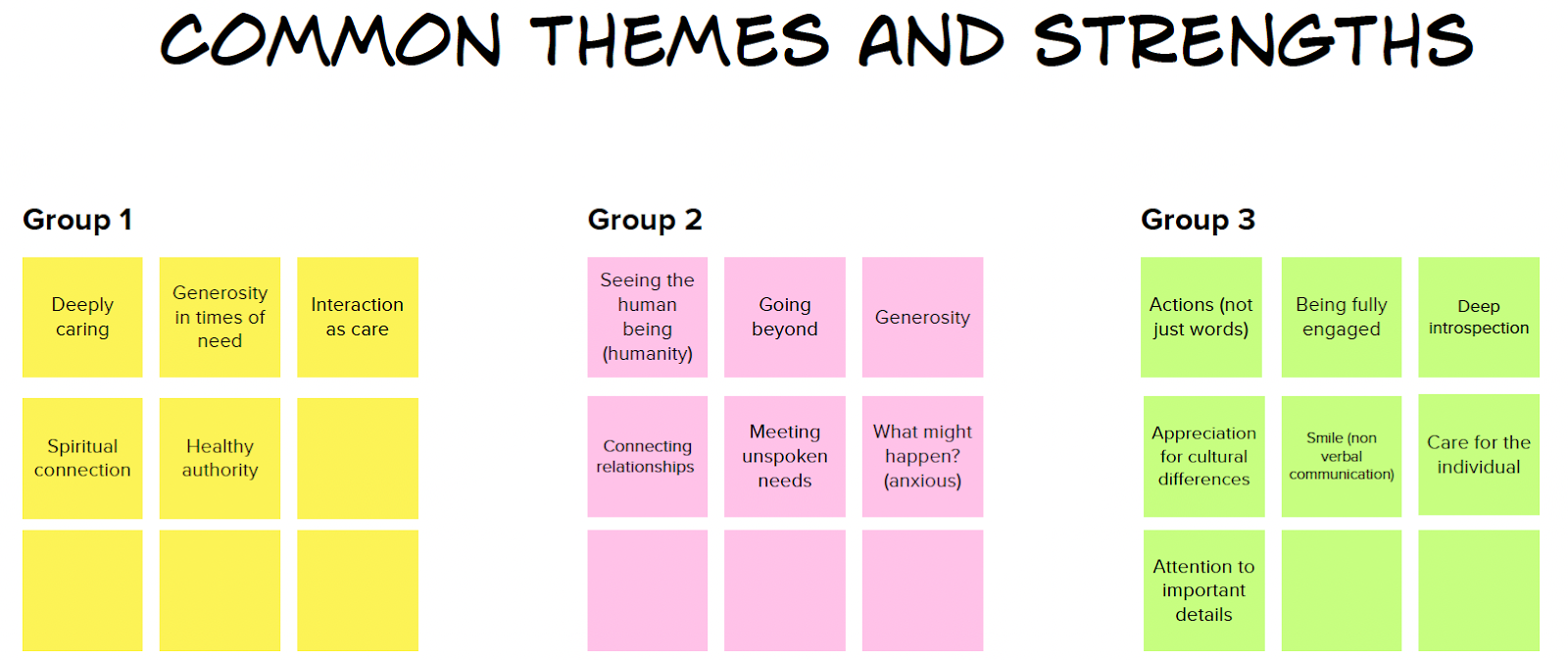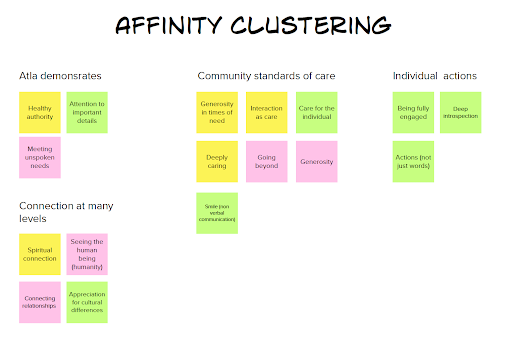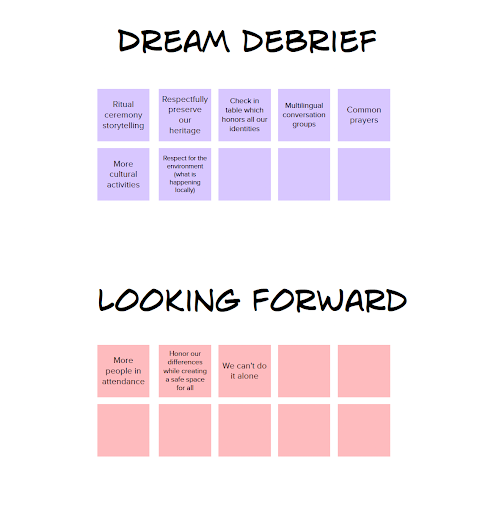Relationships, Relationships, Relationships
Connecting through Atla
Abstract Professional relationships that are respectful and caring form the basis for success for theological and religious studies librarians individually and collectively, especially in a rapidly changing world. Atla’s core values include “hospitality, inclusion, and diversity.” Atla has a history of diverse individuals coming together for a common purpose; there is also a trajectory of moving toward greater diversity. This workshop, which originated from a conversation between two Atla Board of Directors members (Susan Ebertz and Karl Stutzman) following a board learning experience with Indigenous leaders, included expert facilitation (Nancy Kirkpatrick) around a variety of questions related to continuing to build respectful relationships within the association.
Introduction
This Atla Annual workshop session included presentation content and facilitated group activities. The workshop began with introductions, centering, land acknowledgement, and ground rules. Karl and Susan shared the story of how the workshop originated along with the way their relationship has emerged through years of connecting through Atla.
This workshop began as a conversation between Susan and Karl about professional relationships and Atla’s core value of hospitality. The conversation was the outcome of a learning experience at the November 2022 Atla Board of Directors meeting in Vancouver, in which Camille Callison, the first Indigenous university library director in Canada, said the central takeaway should be “relationships, relationships, relationships.” Atla is a rich web of relationships for theological and religious studies librarians, and Atla’s hospitality for diverse faith orientations, race and ethnicity, cultural backgrounds, and political views is a tremendous resource to draw upon as we build libraries and learning communities that are relevant in an online and networked world. Atla is expanding its horizons to include an increasing variety of diversity dimensions as it leans into a vision of global interaction and attends to issues of diversity, equity, and inclusion.
Indigenous Wisdom for Atla: Karl Stutzman
At the Atla Board educational experience in Vancouver in November 2022, we learned a number of key things that Atla as an organization can benefit from as it moves forward.
One of these is a sense that humans and their environment are an integrated whole, a web of relationships between people, plants, animals, sky, water, etc. All benefit together, and what is good for the whole is what is good for humans and vice versa. Relationships, broadly defined, are fundamental to our existence. We harm each other and our environment at our own peril.
Another of these learnings is that we can develop protocols, just as the Indigenous community in the Canadian Pacific has done, to both create interconnectedness and honor core group identities. Remarkably, the Indigenous groups in the Vancouver area have maintained very distinctive languages and cultures while intermarrying and socializing together because they have strong protocols for their interactions, ways of treating each other with respect and dignity. One example of a protocol that our leaders gave to us was that when an elder approaches a village in a canoe, the younger persons in the community go out into the water and carry the canoe in as a sign of respect and hospitality. What might Atla’s protocols be that ensure respectful diversity, not homogeneity?
Artificial and Real Intelligence: Karl Stutzman
We’ve all heard about ChatGPT and related artificial “intelligence” tools that convincingly do things that used to be the exclusive domain of humans, like writing essays. What does this mean for us as academic librarians? Are we suddenly out of a job? A book I read on this topic, Robot-Proof by Joseph Aoun (2018), addresses the issue of artificial intelligence and what it means for higher education. Aoun, president of Northeastern University, emphasizes the need for what he terms human literacy in the coming age. He writes that human literacy is the most important of the three new literacies he proposes (the other two are technological literacy and data literacy), and that “perhaps especially in the robot age, what matters is other people” (Aoun 2018, 58). He goes on to say that “understanding the importance of diversity is essential to human literacy” (Aoun 2018, 59) and that we need to particularly understand ethics in an age of machine learning. (Aoun 2018, 60-61)
In short, we need real intelligence more than ever in an age of artificial intelligence, and that real intelligence includes strong attention to diversity and ethics, things that matter to the Atla community. Our attunement to human literacy as theological librarians means we can ride out the choppy waves of disruptive technology.
Talk Story: Susan Ebertz
I was born in Hawai’i and grew up there. The culture is a mixture of the various ethnic groups who came to work in Hawai’i or to find a better life. Many were brought to work on the sugar and pineapple plantations. In order for them to communicate with the other ethnic groups, Hawai’i pidgin was born with its own vocabulary and grammar, a conglomeration of the different groups. In Hawai’i pidgin we “talk story.” It is a way of passing on wisdom, telling funny stories, sharing a bit of ourselves in a casual way, an interactive way of creating dialog amongst people of multiple perspectives. Sometimes when we pau hana (finish work), we may sit around and talk story. I find that talk story is an interactive way of creating experiences. It is multi-modal in that we may use different ways of communicating. It is trans-cultural because the different cultures are describing what they are doing. It uses multiple intelligences because it speaks to the different ways of understanding through story telling.
So, now we talk story. Leslie Engelson, a member of the Atla Board of Directors, summarized her learning from some First Nations people by saying, “The ethos of caring for the heart of the other resonated with me as reflecting the true meaning of hospitality. It goes beyond courtesy and respect to treat each person with value.” I was struck especially by the words “caring for the heart of the other.” How much easier is it to be nice to someone. When we care for the heart of the other, we are expressing what true love is. My reaction to our time with the First Nations people was to say, “relationships, relationships, relationships.” Building relationships is one way of knowing what is in the heart of the other. We can create these relationships when we talk story: sharing those bits of wisdom, funny stories, and a bit of ourselves. They begin to know what is in our heart and we then begin to know what is in the heart of the other.
Barriers keep us apart from each other. Sometimes we create barriers because someone has hurt us. It’s like a scab protecting a wound. Sometimes we create barriers with new people who remind us of the person who hurt us. We think that these new people will do the exact same thing to hurt us. These barriers are often hard to break down. They are ingrained in our response system. Things which are familiar are easier to deal with than the unknown. We are afraid when those familiar ideas, places, and interactions are replaced by new things. It’s hard to build relationships in these situations. For example, when we physically attend Atla Annual, it is sometimes easier for us to hang out with our friends than to meet new people.
What’s even harder is to become peacemakers. In Da Jesus Book, the dynamic equivalence of Matthew 5:9 is “Da peopo dat help da odda peopo come friends again, Dey can stay good inside Cuz God goin say, ‘Dey my kids.’” (Wycliffe Bible Translators 2010, 11) If we are peacemakers, bringing people together or become friends again, we will be called children of God. We will become God’s ohana, helping peopo come friends again. Some of you may have heard of the movie, Lilo & Stitch. In it, Lilo says, “Ohana means ‘family.’ Family means nobody gets left behind or forgotten.” When I was growing up, the neighbor across the street was “aunty,” the guy down the block was “uncle.” Though they were not my blood relatives, they were my family, my ohana. We are God’s ohana, and we are called to bring people together to become friends. The first step, then, is building relationships and recognizing that we are already a part of the ohana.
Atla DEI Events

IMAGE 1 “Atla DEI Event Timeline”
Appreciative Inquiry and Brain Science: Nancy Kirkpatrick
When deep respect is present, the energy between people or the tone in an environment is palpable. We can see it, feel it, and hear it. It touches us. The indicators that respect is a value that is truly lived out are in the behaviors and interactions of individuals. People listen carefully; they are courteous and patient, inquiring and seeking to understand. The pace in our lives has sped up and diversity is enriching our communities. With that, it seems we need to be even more mindful of how we impact others as we rush about. A smile, allowing someone to go ahead of you, showing gratitude for a kindness or acknowledgement, and eye contact when appropriate not only make you feel more generous to others, but it has a domino effect as well. Those to whom we show genuine respect are more likely to exhibit similar respectful behaviors and courtesies to others. What does it take to make respectful relationships contagious? What is our personal role in that?
We conducted an Appreciative Inquiry. Appreciative Inquiry distinguishes itself from other organizational visioning and change models by focusing on the best of what is and using this as a platform to build future directions. While many traditional methods begin by focusing on pitfalls and problems, Appreciative Inquiry asks people to explore strengths and successes that already exist, both internally and externally. This positive approach leads to extraordinary performance by reinforcing relationships and culture, creating common vision and direction, promoting learning and innovation, and energizing collective action.
Why does it work? Science. When we say that words have power, we mean it. And science supports it. We focus on positive conversations for this reason.
Negative conversations trigger the release of stress hormones: cortisol, norepinephrine, and testosterone. This results in the need to protect “me”:
- Increased blood pressure
- Immune system suppression
- Oxygen and nutrients to the reptilian-complex in the brain and the large muscles (fight, flight, freeze, appease)
- Inhibits access to neocortex and pre-frontal lobe, home to higher order thinking, creativity, and the ability to connect with others
Positive conversations trigger happiness hormones: oxytocin, serotonin, dopamine, and endorphins. This results in openness and the ability to connect as “we”:
- Enhanced immune system
- Relaxation response
- Oxygen and nutrients flood the entire brain
- Full access to the neocortex and pre-frontal lobe, broadening and building the capacity for higher order thinking, creativity, and the ability to connect and bond with others
If we want to come together and work more effectively, it helps to literally be in the right mindset to do the work, and Appreciative Inquiry is one way to get us there. As a group, we worked through the Appreciative Inquiry presented below.
Focus 1 – Stories of Respectful Relationships: Paired Interviews
- Consider a service or business encounter you have witnessed or experienced during which you could tell that respect for people was a value not only talked about, but actively lived in this organization.
- What was your experience of respect about?
- Describe what was happening.
- Who was involved?
- As you recall that story, how did you react? What thoughts, feelings and actions did you experience?
- What was memorable about the respectful experience?
- What were the indicators that respect was highly valued in this business or service organization?
- Was it the service level, communication, style, language, product, courtesy, attention to detail, follow-up, efficiency, respect for their environment?
- What made the real difference?
Focus 2 – Integration of the Best Examples
Interview pairs combine to form groups of 4 or 6
- In your small groups, interviewers will introduce their partners and share the highlights of the stories they heard.
- As you listen respectfully, what are some of the common themes or shared strengths that came out of the stories on this topic of Respectful Relationships?
- Many organizations have respect as a core value: respect for employees, customers, or environment, to name a few. What else can you identify from your own stories about respect as part of the culture?
Focus 3 – Projecting Your Best Examples Forward
Group size to be determined by number of total participants
- Imagine you fall into a deep sleep and, when you awaken, it is 2023 and you come into the Atla conference to find all the best examples of respectful relationships are now being practiced. They are fully integrated into your culture and organization and demonstrate an uncompromising respect for people and the environment. What would that look like, sound like, feel like?
- Create a scenario or short skit or come up with a metaphor or song that shows respectful relationships with all your colleagues within the Atla conference environment.
- Enjoy yourselves as you present your creativity to other groups.
Focus 4 – Respecting Your Relationships
- What does it take to sustain respectful relationships? For example, is it up to individuals, officers, policies, leading by example?
- What would you propose? What new elements can you introduce?
- How would you communicate to others the importance of showing respect? What benefits do you envision?
- What’s been the most valuable things you’ve learned or re-learned about respectful relationships as a result of this workshop?
- What are you taking away that will strengthen your respect for yourself and for others?
The Results
Once we worked through the Appreciative Inquiry, groups shared out their results, which are captured below.

IMAGE 2 “Common Themes and Strengths”
 IMAGE 3 “Affinity Clustering”
IMAGE 3 “Affinity Clustering”

IMAGE 4 “Dream Debrief and Looking Forward”
References
Aoun, Joseph. 2018. Robot-Proof: Higher Education in the Age of Artificial Intelligence. Cambridge: MIT Press.
Lilo & Stitch. 2002. Directed by Chris Sanders. Walt Disney Home Entertainment.
Wycliffe Bible Translators. 2010. Da Jesus Book. Orlando: Wycliffe Bible Translators.